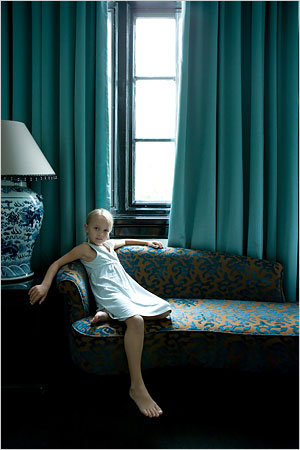Room to Improve
February 14, 2008 | By Stephen Milioti
Q. Where can I find lightweight draperies that will block out the light?
A. Many people assume that to get total darkness, especially in the bedroom, they need curtains that are as heavy as the ones at Radio City Music Hall. But there are plenty of options that will keep your room pitch-black at night.
At the high end, Lori Dennis, a Los Angeles interior designer, recommends having ripple-folded faux-suede draperies custom made. “Faux suede gives a rich, sexy appearance to a bedroom,” Ms. Dennis said, and ripple-folding produces “a more luxurious effect.” Although faux suede is good at blocking out light, she suggests having a drapery maker add a privacy liner.
For a “Hollywood Regency-glam retro look,” she said, you could use taffeta with a subtle sheen instead. Many custom drapery stores sell faux suede and taffeta, but count on spending at least $1,000 a window.
Hunter Douglas Silhouette window shades are less expensive (800-274-2985 or www.hunterdouglas.com) and a favorite of many designers because they have adjustable panels that come in more than 180 colors and fabrics. Prices vary too widely to quote, depending on custom features and window sizes. But even at the highest end, the shades are less costly than custom draperies.
For complete privacy, Kristin Hannah, an interior designer with offices in Chicago and Scottsdale, Ariz., recommends the Bon Soir fabrics in the Silhouette line, which should keep a room dark at night and reduce sunlight by 70 percent during the day, the manufacturer says.
For colors, Ms. Hannah said, try to approximate the colors in the room. “I would suggest selecting a treatment color that matches as close as possible to the paint color of the room — which should not be white,” she said. “Doing this will provide a clean, stylish look to the room and not steal attention from other dramatic elements such as the bedding or artwork.”
Smith & Noble (800-248-8888 or www.smithnoble.com) is one of Ms. Dennis’s favorite sources for window treatments. “There are so many different choices,” she said, “that you really should call and talk to one of their window-coverings experts to discuss what you want. They’ll help you get the right thing. It’s the closest to a custom design job that you can get without having an interior designer.”
She recommends Natural Woven Shades (starting at $134) — 75 environmentally responsible materials, from bamboo to hand-woven grasses, reeds and paper yarns, in neutral colors. They are ultralight, yet many can be purchased with a blackout liner.
West Elm, Ms. Dennis’s third recommendation, offers the most affordable option: a two-color linen window panel ($49 to $74) that comes in neutral color combinations like ivory-espresso and putty-clay (888-922-4119, www.westelm.com). It won’t block out sunlight as well as more costly choices, but you can buy blackout drapery liners at stores like Target (around $50 for a pair of 80-inch-square panels at www.target.com).
“Adding a blackout panel or privacy liner to a layered drapery presentation is something we designers do a lot,” said Estelle Jaivin, a Los Angeles designer, because it allows for a wider choice of drapery fabrics. “Just make sure that liner doesn’t show much,” she added, “because it’s rather plain-looking.”

